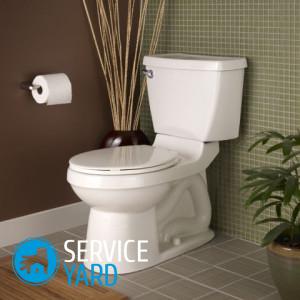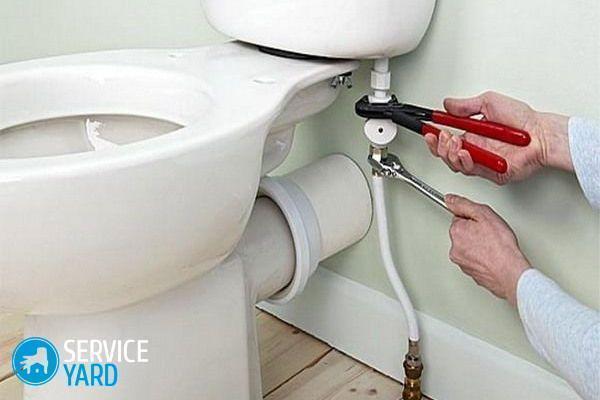How to install a toilet in a private house?

Installation of plumbing in an apartment building is not particularly difficult, if only because communications are usually unified. Private home is a completely different matter. The field for imagination here, as they say, is uncultivated. The type of communications and building materials used depends only on the owner’s ideas. Therefore, many different factors affect the way you install the toilet. Consider the different options on how to properly install the toilet in a private house.
to contents ↑Toilet bowl and sewer drain: compatibility issues
The way to install the toilet is affected, first of all, by the method of discharging wastewater.
Vertical
Sewer pipe goes into the floor vertically. This type of descent is considered obsolete. Despite this, vertical drainage is used in private homes, when the footage of the toilet is small, and you need to save space. Plumbing in this case is mounted directly on the pipe.
Horizontal
The toilet is attached to a horizontally mounted fixture. This method of laying sewage is by far the most popular.
Depending on these data, you also need to select plumbing. There are three types of toilets:
- Oblique release. A universal option suitable for both types of sewage.
- Horizontal release. Such a toilet can be connected to a horizontal pipe.
- Vertical release. This type of toilet is suitable for vertical drainage.
Important! In addition, there are hanging and floor toilets. The outboard version has not yet received wide distribution due to the relatively high price.
In both cases, fan, plastic or corrugated pipes, as well as eccentric cuffs, are used for the connection.
Fan pipes are the most aesthetically winning option. They, together with the toilet, visually form a single whole. Material for the manufacture of fan pipes can be:
- China.
- Half porcelain.
- Faience.
Important! Since these pipes are based on ceramics, they cannot be shortened or bent. Corrugated pipes with eccentric cuffs make it possible to connect even in the most difficult places to access. The corrugated sleeve is very flexible, but has significant drawbacks: if it stretches very much, it becomes less durable. In addition, the throughput of such pipes is small, blockages are not uncommon. To reduce the risk of accidents, it is worth choosing corrugated pipes with thick walls.
Plastic pipes are easy to install, practical and reliable. For this reason, when installing toilets, they are most often used.
to contents ↑How to install a toilet in a private house on a wooden floor?
If the task is how to install a toilet in a private house on a wooden floor, there are 3 ways of installation:
- On the glue.
- On the dowels.
- To taffeta.
How to plant a toilet on dowels?
This is the most common and easiest way, the popularity of which is explained by small labor costs. To fix the toilet on a wooden base, special connections (dowels) are used, which often come in the same set with plumbing.If there are no fasteners in the kit, you can buy them at a hardware store.
Important! Dowels have a limited area of use:
- If we are talking about a massive stone or cast-iron structure, they will not be able to ensure the stability of these products. This mount is used for toilets made of earthenware or sanitary porcelain.
- This method is not suitable for uneven floors. The toilet simply runs the risk of flying off the mounts due to height differences.
Consider the procedure for installing the toilet on the dowels in stages.
Backing
When installing the toilet on a wooden floor, the craftsmen do not recommend mounting the product directly on the base. Between them, it is desirable to install a gasket (for example, from linoleum).
Important! The gasket is needed in order to make the place of contact of the surface of the floor and the toilet more tight.
The substrate is made as follows:
- Put the toilet on linoleum and circle the outline.
- Now it remains to cut out the substrate of the desired size and shape.
Markup:
- Place the toilet on a wooden base and draw a contour. At the same time, chalk is preferable to a marker, since removing its traces is much easier than from a marker.
- Seal the contoured area with sealant, stick a prefabricated substrate on it.
- After the glue has set, you can start drilling holes for the dowels.
- If you want to slightly raise the plumbing above the floor, you can use a wooden stand. For this, a board with a thickness of 30-40 mm is used, which, like the substrate, needs to be cut along the contour of the base. In this case, the board is laid first, and a substrate made of linoleum or rubber is glued to it.

How to distribute fasteners?
Focus on the diameter of the special holes for mounting. Mark the location of the holes on the surface of the substrate and proceed with fastening.
Important! Experts advise using a drill with a diameter slightly smaller than the mounting holes. In this case, the plumbing will be more stable.
Drive dowels into the holes drilled in the tree and install a toilet on them. Tighten the fasteners. All. The work is over.
Important! Do not overdo it by tightening the fasteners. The pottery the toilet bowl is made of may crack.
How to connect the toilet to the sewer?
For this, corrugation is used. This is a pipe made of plastic, having the shape of an accordion, which stretches to the required length. Connect one end of the corrugation to the toilet outlet, and insert the other into the socket of the sewer.
Important! To seal the joints, pre-grease the corrugation on both ends with liquid silicone. Reinforced adhesive tape allows you to make the connection even more durable and tight.
How to install a toilet with your own hands in a private house on epoxy glue?
In terms of labor costs - this is the least time-consuming method, but with the operation of the toilet will have to wait a bit until the epoxy is completely frozen.
Important! If you put the toilet on the dowels, you can immediately start using it, then when using epoxy glue, you will have to wait about half an hour.
Which glue to choose?
The following types of epoxy glue are on sale:
- One component. This is a finished mixture of epoxy and hardener.
- Two-component (two tubes: with epoxy resin and hardener). After both components are mixed in a certain ratio, a suitable composition is obtained.
Epoxy also varies in degree of thermal activity. Some compounds require heating before use, others are used cold.
Important! For the installation of the toilet, you can use various epoxy compounds, but working with a single-component is much easier.
We stick a toilet on a tree
How to use to properly install a toilet in a private house:
- Before installation, the base of the toilet bowl and the floor area are coated with epoxy glue, having previously cleaned and degreased the surfaces.
- The wooden surface is also sanded to improve adhesion.
- During installation, make sure that the toilet seat is parallel with the sewer pipe, otherwise it may cause difficulties with connection.
- Remove excess glue immediately with a damp cloth, without waiting for the composition to freeze.
Important! At the end of the work, you can’t even touch the toilet. Hato after 12-15 hours plumbing will be linked to the floor literally tight.
If you make glue yourself
If there is no epoxy glue on sale, you can make it yourself:
- Resin ED-6 - 100 parts.
- Solvent - 20 parts.
- Hardener - 35 parts.
Do it yourself glue:
- Heat the resin in a water bath and mix with solvent and hardener.
- Then add dry cement (200 parts).
Important! It is important when mixing to observe exactly this order of combination of ingredients.
Plumbing on taffeta
This is a universal method. It is also suitable for mounting the toilet on an old swollen wooden floor.
Important! Taffeta is a wooden substrate carved in the shape of the base. The thickness of the wood is from 30 mm. It is important to choose a quality tree, without rotted sections and knots.
How to put a toilet on a wooden floor with taffeta?
Taffetas drive nails into the “inside” so that the hats protrude 20-30 mm above the tree. Nails act as anchors, make the structure more rigid.
The algorithm for installing plumbing on taffeta:
- Pouring cement-sand mortar screeds.
- Inserting taffeta into the screed (with the anchors pointing down). It is necessary to ensure that the combination of screed and taffeta is complete, without bumps and gaps.
- Connection of taffeta and toilet bowl with screws.
- In order not to damage the ceramics, rubber gaskets are placed under the heads of the screws.
- The last stage is carried out after the screed hardens completely.
to contents ↑Important! Taffeta made of wood plays the role of a shock absorber, which does not allow splitting the toilet bowl (this happens when installing it on a wooden base).
How to install a tank on a shelf?
To mount the tank you will need:
- 2 bolts.
- Sealing gasket: made of foam or rubber (put on the hole of the drain mechanism).
Operating procedure:
- Rubber washers and gaskets are put on the bolts.
- Now it remains to install the tank in place, align the holes and tighten the fasteners.
- Bolts must be tightened manually, since the key can damage the structure.
- To connect the tank to the water system, flexible water hoses with nuts at the ends are used.
- All threaded connections are sealed with rubber gaskets. It is useful to use FUM tape.
How to install a toilet in a private house on different types of grounds?
In addition to the wooden floor, the bathroom may have other floor coverings. Consider the specifics of installing plumbing on different base materials.
Concrete
Concrete floors are popular in private homes. The toilet is installed on a special “pillow” made of cement. The solution is based on: cement, sand and water:
- First, a wooden or metal frame is laid at the place of installation of the plumbing, and then cement mortar is poured.
- Plumbing is pressed into the cement.
- In this case, excess solution must be quickly removed.
- After the cement has dried, the frame is removed.
Ceramics
In this case, there is no need for a substrate. It is enough to glue the plumbing to the floor using a special composition. The best option is epoxy.
to contents ↑Important! Adding dry cement to the solution improves adhesion.
Stock footage
Whatever method you use, accuracy and accuracy are an indispensable condition for plumbing to serve you long and stable. A sound and responsible approach is important in any case.
- How to choose a vacuum cleaner taking into account the characteristics of the house and coatings?
- What to look for when choosing a water delivery
- How to quickly create comfort at home - tips for housewives
- How to choose the perfect TV - useful tips
- What to look for when choosing blinds
- What should be running shoes?
- What useful things can you buy in a hardware store
- Iphone 11 pro max review
- Than iPhone is better than Android smartphones



